How to make a do-it-yourself sand filter for a pool: step-by-step instruction
Your pool, in addition to the joy of swimming and swimming, gives you chores in the form of quickly polluted water? And the cost of filters for its purification, which are offered in specialized stores, shocked you? Agree, it would be nice to get a filtering device for a reasonable price.
For this, it is not necessary to buy expensive devices. You can make an effective sand filter for the pool with your own hands, which will adequately clean the water from foreign inclusions. We will help you to cope with this task - the article provides step-by-step instructions on how to make such a filter on your own.
We provided the construction process with visual photographs and videos on the independent creation of simple and effective filtering devices.
The content of the article:
- Do I need to equip the pool with a filter?
- Benefits of Sand Filtering
- Sand Filter Making
- Stage # 1 - getting to know the sand filter
- Stage # 2 - select the connection option
- Stage # 3 - we are preparing the case
- Stage # 4 - embed fittings and internal elements
- Stage # 5 - preparing the filter element
- Stage # 6 - mount devices for filter operation
- Stage # 7 - we carry out the binding of the filtering system
- Stage # 8 - connect the system to the pool
- Stage # 9 - fill the filter with sand and start
- The nuances of operation and maintenance
- Conclusions and useful video on the topic
Do I need to equip the pool with a filter?
Owners of small inflatable and stationary pooloften do not think about water treatment. After bathing, it is simply used for household needs and watering the garden.
If necessary, the tank is again filled with clean water. However, this method is justified only for very small inflatable pools.
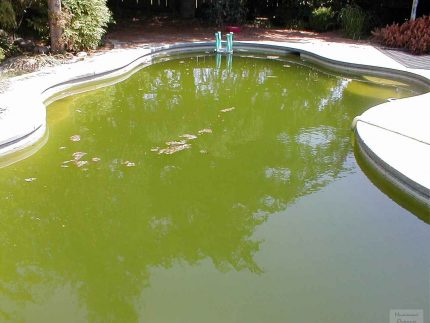
But even trouble with them is enough - the water is polluted after the first bath. After draining the liquid, the surface must be washed and filled with clean water, which must still be warmed up.But you want to swim in hot weather more than once - children, for example, splash there constantly.
In addition to the pollution that a person arranges, various natural pollutants also constantly get into standing water, these are:
- leaves and grass;
- dust;
- bird droppings;
- pollen of plants.
Large and light garbage is removed from the surface of the pool by the net, the particles deposited on the bottom are removed with a water vacuum cleaner.
However, many substances dissolve or remain in water in the form of suspensions. Under the influence of sunlight and atmospheric oxygen, bacteria and microorganisms begin to multiply actively in such a liquid. It begins to emit an unpleasant odor, to bloom, and can cause poisoning and serious illness.
Therefore, it is necessary to clean not only the surface and sedimentary formations, but also the water column itself. An effective way to keep water in good condition all the time is to turn on effective filter into the water supply system.
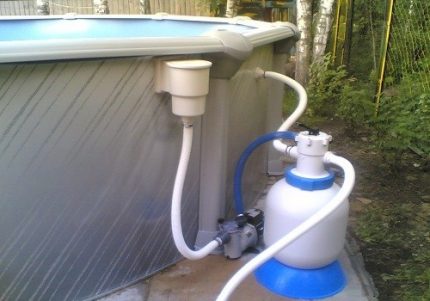
Benefits of Sand Filtering
To clean water in the pool, three types of filters are used:
- diatoms;
- cartridge;
- sand.
Diatom. The best quality of cleaning and reliability of work is ensured by the diatom (also called diatomite) type of filtering device. However, such an aggregate is expensive due to the use of an expensive product that performs ultrafine filtration and adsorption, in addition, eliminating a number of bacteria.
The filter elements of the cartridge variety are the devices underlying the name of this group of filters. This is the most convenient, but not very popular because of the price, a variety of water purification devices. True, they are more affordable than the previous ones.
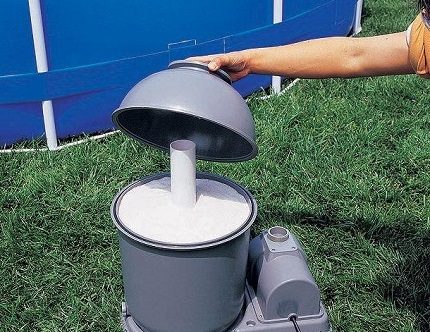
Cartridge Devices have a simple design, are easily disassembled for cleaning and replacing the main element. The cleaning component is a cylindrical cartridge consisting of polypropylene membranes.
Such filters have low performance, so they are suitable only for small pools. Cartridges themselves often have to be washed (once a day) and changed.

Sand filters able to efficiently serve sufficiently large tanks. The filtering layer is quartz sand. Units have a simple device and can be assembled on their own. At the same time, the cost of the finished cleaning system will be approximately half the purchase price.
In addition to mechanical methods for water purification in the pool are also used chemicals, contributing to the deposition of contaminants in the sediment, after which they are simply collected with a net or similar device.
Sand Filter Making
Sand filter for the pool has a simple and reliable device. The main components of the structure:
- sealed container with a wide neck;
- supply pipe;
- sand;
- intake device;
- outlet pipe.
The sand tank is made of a material not subject to aggressive action. Most often, plastic barrels are used for this. At the bottom is a device for collecting purified water.
This is a small drainage chamber to which a discharge pipe is connected. Its walls are made of fine mesh, the mesh size of which is smaller than the particles of sand used. The filtering element is purified sand with fractions of 0.4-0.8 mm - quartz or glass.The first is a democratic option, needs to be replaced every 2-3 years.
The second is more expensive, but it lasts for 5 years. There are multilayer models. The filler in this case consists of layers with different sizes of fractions - from larger to smaller, or from several types of filtering elements - sand, anthracite, gravel.

Stage # 1 - getting to know the sand filter
The principle of the filter is to mechanically screen particles suspended in the water column (mineral and organic origin) by passing it through the sand in the vertical direction - from top to bottom.
The tank is not completely filled with a filter element. When the container is closed, a sealed receiving chamber is formed above the surface of the filler, into which water flows from the pool.
Seeping through the layer of the filter element, the water is purified. Pollution settles on the particles of sand, so it should be quite small. Clean water accumulates in the bottom drainage chamber, from which it enters the pool through the outlet pipe.
Liquid is pumped through the filter by a pump, which is installed in the immediate vicinity of the tank. It can be installed on the supply line (in front of the filter), or on the outgoing line (between the filter and the pool).
In the first case, a small pressure is created in the intake chamber of the filter, which forces water through the filler. In the second case, the absorption of fluid from the drainage chamber creates a small pressure in the upper part, so that water from the pool is sucked into the system.
As the operation progresses, the filter element gradually fouls. The quality of cleaning is reduced. To resume normal operation of the unit, the sand is washed.
To do this, clean water from the pool is passed through the filter in the opposite direction - from bottom to top. Suspension flushing fluid is removed from the top of the filter into the sewer.
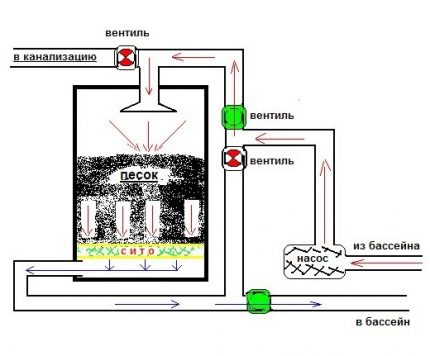
The construction of a sand filter for the pool with your own hands will save almost half the cost of a similar purchased unit. This is subject to the use of new components. If some individual elements and suitable improvised means are already available, then the savings will be substantial.
Stage # 2 - select the connection option
There are three filter connection schemes regarding pump for pool:
- The pump is installed in front of the sand tank. At the same time, water is pushed through the sand under pressure, which creates a pump installed in the feed in a hermetically sealed filter container.
- The pump is installed after the filter. This creates a suction and vacuum depression in a hermetically sealed container with sand. Due to this, fluid is sucked from the pool into the tank.
- The pumping of purified water is carried out by a pump installed after the filter. Water from the pool flows by gravity into the sand tank.
Industrial-made sand filters perform cleaning according to the first scheme. They are equipped with pressure gauges and a safety group for venting excess pressure.
When designing with your own hands, the choice of connection option largely depends on the components already available in the farm, on the type of pool and how the drains are organized in it.
Stage # 3 - we are preparing the case
If there is a sealed container of sufficient volume capable of working under pressure, then you can safely build a filtration system according to the first scheme.
The filter chamber can be a housing from a membrane expansion tank. In this case, it must be freed from the “pear” (membrane) and treated from the inside with a paint that protects against the formation of rust.
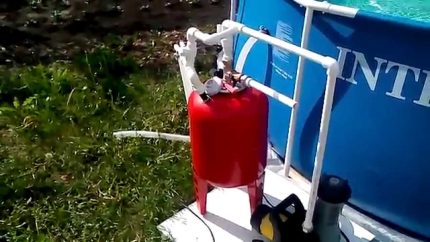
You can also use a polypropylene barrel with a volume of at least 60 liters. Such are often available at the dachas. This material is resistant to aggressive effects and is not subject to corrosion. But not all of them can withstand the pressure. Most often, in such home-made designs, it tears out the lid, but the case itself may burst - in a thin place.
Ideal for organizing water filtration according to the second or third scheme plastic containers. However, if water is pumped by suction, the lid is installed with additional sealing. Even a small air leak affects the system.
Stage # 4 - embed fittings and internal elements
It is necessary to ensure the entry of dirty water into the filter and the pumping of purified water. To do this, fittings are cut into the walls of the housing, or into the cover. The tie-in areas are carefully treated on both sides with a sealing compound.
Attach to the feed fitting coarse filterprotects against large debris. It can be a finished cartridge, or a home-made device - for example, the conical part of a plastic bottle covered with a nylon stocking.
In addition to its main function, such a part will play the role of a diffuser, so that a stream of water entering the filter is sprayed and does not "dig" sand. A water intake is prepared, which can be any perforated container with an additional close-fitting fine mesh, the cells of which are smaller than sand granules.
For the manufacture of a simple water intake drainage device, you can use a piece of plastic pipe with soldered holes, which is covered with a covering garden material on top. Or use a ready-made, commercially available, cylindrical cartridge, which is used to filter drinking water.
On the one hand, the cylinder is plugged tightly, and on the other, a corner fitting is cut into the plug, ensuring the tightness of the connection. A pipe is attached to the device for connection with the fitting. Lay it horizontally on the bottom of the filter.
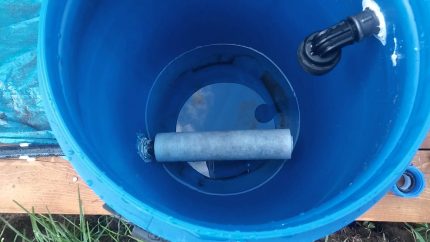
Stage # 5 - preparing the filter element
It is most advisable to use ready-made quartz sand, specially designed for the pool. Its granules have an optimal size of 0.4-0.8 mm.
The filler is clean, disinfected and requires no preparation before use. Standard package weighing is 25 kg each. A medium-sized pool — between 15 and 40 cubic meters — will require two of these bags.
Ordinary sand is better not to use. A small version of it is prone to clumping and the formation of direct vertical channels in the filter layer, while a large one will not clean it properly. This can lead to a decrease in the quality of the treated water or to a complete non-fulfillment by the filter of its main function.
Perhaps the owners have quartz sand, but not prepared. Then pre-treatment should be done before use.
The filler is sieved through a sieve that does not allow particles larger than 1-1.5 mm. Then it is washed.This operation can be carried out already in the filter - turn on the backwash mode and let clean water through the sand until it becomes transparent.
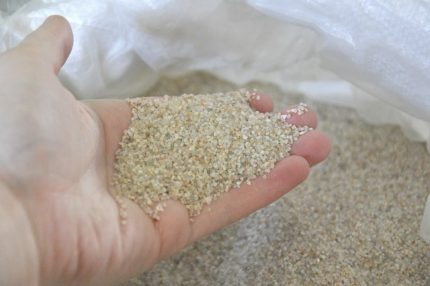
Stage # 6 - mount devices for filter operation
When implementing the injection circuit, it must be established pressure gauge. It can be in the line between the pump and the filter or attached to a fitting embedded in the tank cap.
Instead of a manometer, you can use the device - security group. This is a small collector to which a pressure gauge, safety valve and air vent are attached.
By adjusting the instruments to the required parameters, you can avoid such troubles as a lid breakdown during the manufacture of a filter from a polypropylene barrel. If the pressure is exceeded, the safety valve will simply drain the excess liquid, and the design will remain intact and operational.
Air vent the system will also not be superfluous, since water saturated with air circulates in the system. Standing out, gas can accumulate under the filter cover. For an installation that works on the principle of “sucking” water into the filter cover, it is advisable to insert an air vent - a small diameter pipe with a tap.
In case of accidental airing of the system or suction of air, it will be enough to open the air vent valve and wait until water flows out of it. Then the tap should be tightly closed.
Stage # 7 - we carry out the binding of the filtering system
In industrially manufactured sand filters, a six-position valve is used to switch modes.
In the case of self-assembly, make piping with the correspondingly located valves and fittings. The design should provide at least two operating modes of the system - filtering and washing sand.
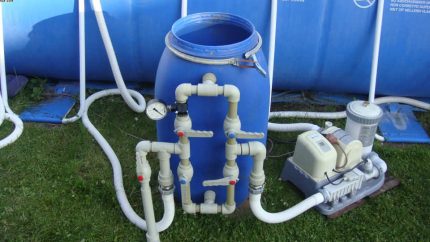
The pump for the filtration system does not have to be very powerful. Enough 150-300 watts. Performance is selected taking into account the fact that a complete replacement of the contents of the pool should take place no more than 6 hours.
So for an artificial reservoir of 20 cubic meters, you need to choose a pump with a capacity of at least 4 m3 / hour. Choosing a pump more powerful should not be, since the unit is used in conjunction with a filter. Their performance should be equivalent.
A powerful pump will pump liquid through the filler too quickly, as a result of which the quality of cleaning will decrease and the filler will fail earlier.
Stage # 8 - connect the system to the pool
Using clamps to the outlet fittings of the filter system, we connect the hoses - supply and discharge. If the pool has ready-made nozzles in the walls, then the hoses are connected to them. You can just throw the hoses overboard.
The intake of liquid from the pool and the discharge of clean water should be located as far as possible from each other. This is necessary to ensure good circulation and to prevent the formation of dead zones in a pond.
Before the pump, wherever it is located, a coarse filter must be installed. This will prevent internal damage to the unit.
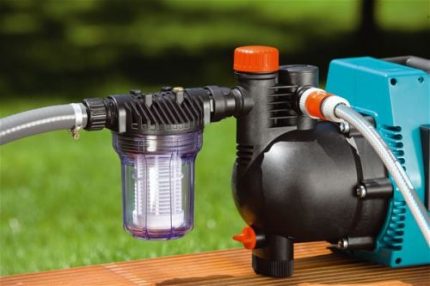
For a gravity-filled system, the top surface of the barrel should be located below the pool water mirror. At the same time, approximately equal flows should be ensured - that is, the amount of incoming liquid should be commensurate with the amount of suction.
To do this, at the junction of the hoses with the pool, taps should be installed to help regulate the pumping.
Stage # 9 - fill the filter with sand and start
The container is filled with a filter element, leaving a place for water to flow in from above. As they backfill, sand is poured with water so that it is compacted sufficiently tightly. Water is allowed into the filter line, since the pumps cannot be switched on without liquid.
Make a test run of the filter and check all connections for leaks. When they are detected, the pump is turned off, the water is drained and the system is sealed. After eliminating all design flaws, the filter line is put into operation.
The nuances of operation and maintenance
Wishing to build private pool in the country think in advance and provide for ways to service it. Water should be filtered constantly, especially if it is initially dirty (for example, rusty) or has managed to turn green after a forced outage.
If the water is clean, then in order to save electricity, you can turn it on twice a day for 5-6 hours or once for 10-12 hours. During this time, the entire volume of water in the middle reservoir is 15-20 cubic meters. m will change twice.
During operation, the filter element is covered with a layer of contaminants, which interferes with the further operation of the unit. Therefore, sand should be washed.
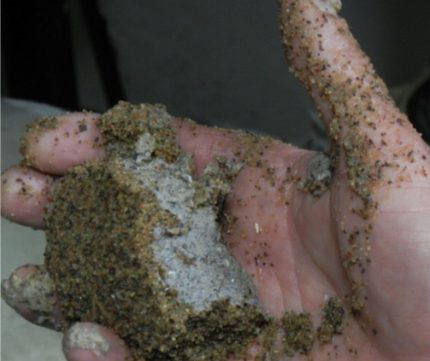
Procedure # 1 - Flushing Filler
The frequency of cleaning sand from pollution depends on the intensity of use of the pool, the degree of contamination of the contents, composition and amount of chemistry used. You can use the recommendation to rinse the filler once every 7-10 days. However, for a pressure-type filtration system, the pressure gauge should be monitored.
A system pressure of 0.8 bar is considered normal. If the indicator has reached 1.3 bar, then the sand needs to be washed.
For the cleaning process, it is necessary to ensure the flow of water under pressure into the lower filter chamber - into the intake device. To do this, arrange the appropriate wiring in advance, so you can change the flow direction by simply switching the taps.

If the wiring is not mounted, then you can rearrange the hoses. For the discharge system, the hose from the upper fitting is removed and attached to the lower (to the fitting connected to the water intake). If the pump is on the suction, then transfer the hoses from the pump.
The suction is disconnected from the fitting of the intake device and connected to a source of clean water or lowered into the pool. Pressure - connect to the outlet of the water intake. A hose is attached to the upper fitting to drain the flushing fluid into the sewer or in a separate container.
The pump is turned on, and water under pressure loosens and leaches the accumulated layer of dirt. Sand should be washed until the drained wash liquid becomes clear.
Procedure # 2 - replacing sand in a filter
Gradually, the filter element becomes heavily clogged with fatty and organic substances, skin particles and hair. Such sand is no longer able to provide proper water treatment. Therefore, it must be replaced completely.
The filler is replaced as follows:
- Close the tap on the water supply.
- Pump up the remaining water as much as possible - if the pump is on supply, then a lot of liquid will remain in the filter.
- Turn off the power to the pump.
- Scoop out all the filler. Contaminated sand is simply teeming with bacteria, so you should do this carefully and with gloves, preventing it from reaching the mucous membranes and eyes.
- Pour some water into the filter tank - about 1/3. The liquid will soften the mechanical effect of falling sand on structural elements.
- Pour the required amount of filter element.
- Open the water supply.
- Perform backwash. If the hose for purified water is simply thrown over the side of the pool, then you can skip this step and drain a certain amount of liquid into the ground when the system starts up.
- Enable filtering mode.
When used as a filler of quartz sand, its complete replacement will be required once every three years.
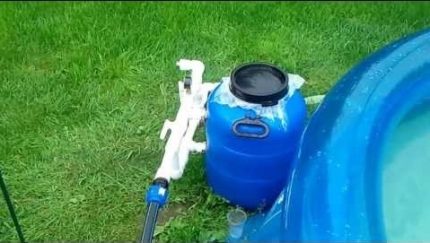
Conclusions and useful video on the topic
Filtration system with feed pump. It works by injecting liquid into a sand tank:
Gravity filter filling system. An example of a good wiring for this type of connection:
An option for a quick device for a homemade filter. Gravity filling the filter system. This option is suitable if urgent cleaning of the contents of the pool is required.
For permanent use, wiring should be mounted to be able to switch to flushing mode:
The correct design of the filtration system and timely service allows you to comfortably use the best summer entertainment for the whole family - swimming in the pool.
Do not rush and just immerse the hoses in the sand - it is better to think about a convenient wiring, thanks to which maintaining an artificial pond will take a minimum of time and will not create hassle.
Do you want to share an interesting design of a sand filter or tell us about the experience of connecting a device to a pool water supply system? Please write comments in the block below. Here you can ask questions.

 How to make a water filter with your own hands: an overview of popular homemade products
How to make a water filter with your own hands: an overview of popular homemade products 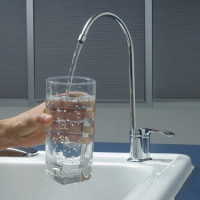 How to choose a filter for water: we figure out which filter is better + manufacturers rating
How to choose a filter for water: we figure out which filter is better + manufacturers rating 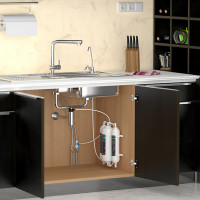 DIY reverse osmosis: step-by-step assembly and installation instructions
DIY reverse osmosis: step-by-step assembly and installation instructions 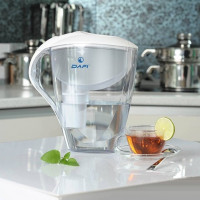 Water purification filter for a summer residence: selection tips + an overview of the best brands
Water purification filter for a summer residence: selection tips + an overview of the best brands 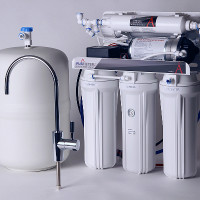 How to choose a reverse osmosis filter: ranking of the best manufacturers and their products
How to choose a reverse osmosis filter: ranking of the best manufacturers and their products 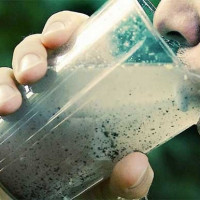 Rating of water filters for washing: rating of the best models and selection guide
Rating of water filters for washing: rating of the best models and selection guide  How much does it cost to connect gas to a private house: the price of organizing gas supply
How much does it cost to connect gas to a private house: the price of organizing gas supply  The best washing machines with dryer: model rating and customer tips
The best washing machines with dryer: model rating and customer tips  What is the color temperature of light and the nuances of choosing the temperature of the lamps to suit your needs
What is the color temperature of light and the nuances of choosing the temperature of the lamps to suit your needs  Replacement of a geyser in an apartment: replacement paperwork + basic norms and requirements
Replacement of a geyser in an apartment: replacement paperwork + basic norms and requirements
When I had to clean the pool twice a week, I immediately began to think about the need to arrange something for water purification. Too expensive and unreasonable to constantly change it, pumping from a well. I myself could not make such a filter as here. I did the wrong connection (I understood it already). I bought it in a store ready and use it. And you could save a lot.
To be honest, I don’t believe that only a sand filter will work well. We have a purchase, one of the cheapest. We watched the video on how to make it ourselves, but in the end we decided that it would be expensive, because there are no tools (and the necessary knowledge). We have a small summer pool, a filter to it. But in addition I buy pills in the water itself. And still, after a week, the water turns green ((
Perhydrol is very helpful.
Try 38% hydrogen peroxide.